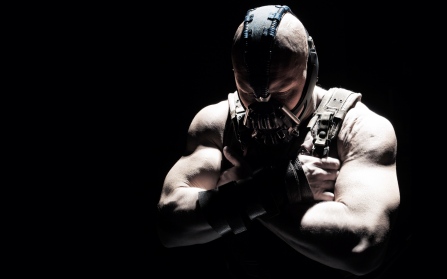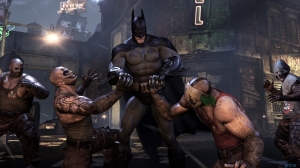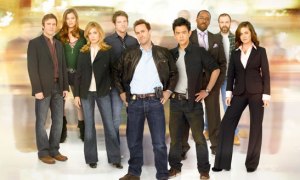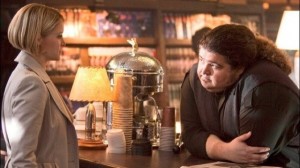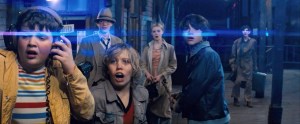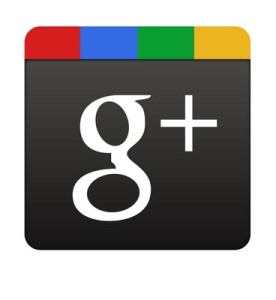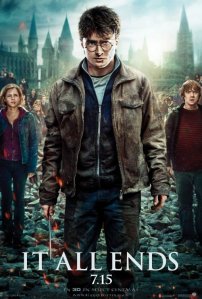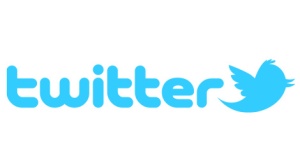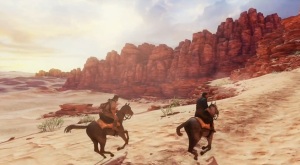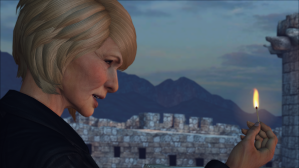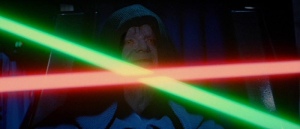It’s that time again!
What time?
If you answered, “Be like every website out there and make a quick list in an effort to summarize the past year,” then you are absolutely correct! There is a precedent for this, however. Last year, I wrote an article summarizing my personal Top 10 Media Disappointments of 2010. About a week later, I countered that with my own Top 10 Surprising (or Notable) Media Successes of 2010. I enjoyed that method of reminiscing last year, so I intend to do it again for this past one! Here are my personal disappointments for 2011. My own successes will come in a little bit.
Join me, will you?
10. Star Wars Bluray
Admittedly, this is the very bottom of the disappointments list, but it still deserves to be on here. The way the Complete Saga was hyped before it was released, you would’ve thought that Star Wars on Bluray was the “Definitive Edition” of the series. Instead, we merely got the “Best Looking Edition.” Granted, the movies themselves look phenomenal, and I still recommend it to those who care about good picture quality and sound. The extra features, however, were majorly lacking. Because Lucasfilm decided not to include any previously-released features from the DVDs (despite the fact that they would’ve all easily fit onto a single Bluray disc), the bonus disc for the Prequels mostly consisted of lame, ten-second deleted scenes. The deleted scenes for the Original Trilogy were admittedly awesome (as they hadn’t been seen before), but that was the high point of the whole set. The final bonus disc was full of ridiculously old, already-aired documentaries and an unfunny “collection” of Star Wars spoofs that felt like it was put together by some middle-aged man in his free time — oh, and they were all in “standard def.” While the movies themselves felt like Lucasfilm had put time and effort in their conversion, the extras discs felt like a hastily slapped together cash-in. The Star Wars Bluray isn’t exactly a bad set, but it is lackluster when you compare it to what it could’ve been.

Of all the Star Wars art I've seen over the years, the Blu-ray cover art isn't all that impressive either.
9. This Year’s E3
The Electronics Entertainment Expo (or E3, for short) is a once-a-year event meant to showcase videogames and videogame-related hardware that is currently in development. Taking place over the course of a week, it’s a very big deal in the gaming community. E3 is often the place where new, triple-A games are announced and previously unseen games are finally shown to the public. Sometimes, even new consoles are announced. Given the kind of budget studios have for this expo, there is always a certain measure of hype surrounding E3 when it finally launches. This year’s E3, however, was very… different. Despite having done this for over 15 years, 2011’s E3 seemed very unsure of who its target audience was. Instead of showcasing all the latest, greatest games to an audience of hungry gamers, most of the execs at E3 either spent their time trying to convince the audience why casual gaming is the future (something Nintendo did five years ago) or breathed hot air about why they’re the best. Microsoft actively paraded children onstage to demonstrate the Kinect, Sony largely ignored the PS3 (despite having a strong lineup of games this year), and Nintendo spent a lot of time talking about the potential of the Wii U without actually demonstrating anything. There were a few notable exceptions, but, for the most part, the higher-ups at E3 felt very out-of-touch with its core fanbase. Worst of all, though, E3 2011 gave us this guy:

Meet "Mr. Caffeine," the world's most awkward show host.
8. The “Big Three” Gaming Companies
Speaking of gaming disappointments, all three of the big gaming companies deserve to be on this list for various actions throughout 2011. By and large, 2011 was a great year for video gaming, but each of the “Big Three” let me down in some way or other this year, even if individual studios were at the top of their game. Sony, of course, dealt with the massive hack of its PSN earlier this year. Naturally, it wouldn’t be fair to hold Sony responsible for the criminal actions of others, but it was the way the company conducted itself after the hack took place that was both disappointing and shameful. For one, the company flat out didn’t tell anyone about the nature of the hack until well over a week after it took place — a very dangerous amount of time when identity theft could be involved. When Sony finally did reveal that it had been a security breach, it was very slow in revealing all the details. It was a full month before the PSN came back online, but it took even longer for Sony to recover its image (if it even has yet). They tried to make good after it blew over, but the whole ordeal was a PR fail of fantastic levels.

Nintendo deserves to be on the list because of its head-in-the-sand attitude. While the 3DS had an amazing amount of potential (it made my list of surprising successes last year), it absolutely failed to deliver. It launched at a high price point, its network wasn’t up and running yet, and there were no notable games to speak of. And it stayed like that for months. The 3DS is finally beginning to catch on — but that’s mostly due to a price reduction and the releasing of games people actually want to play. Similarly, Nintendo released all of two first party games on the Wii for the entire year and somehow had the audacity to wonder why sales were down. I’m not one of those “Nintendo abandoned the hardcore” people, but the company spent so little time paying attention to its current consoles this year that it’s no wonder the company feels a little behind.

By the same token, Microsoft did very little this year as well. Over the past year or two, the house of XBox has been slowly losing its exclusives to multiplatform deals. Because of that, it’s important that the company find some way to entice gamers into sticking with their console. How did MS decide to do that this year? By shoehorning Kinect into everything — including games that really don’t need it (Mass Effect 3, anyone?). Aside from that, it’s been business as usual for the company — with only a very small handful of quality exclusives. Additionally, Microsoft has spent the past few years ruling XBox Live with an iron fist — often bullying small time indie developers with restrictions and demands for large cuts of their profits (it’s no wonder many have migrated to Steam on the PC or even to PSN). Granted, the company’s done nothing blatantly and outright stupid this year like Sony and Nintendo, but, really, the only thing keeping Microsoft up in the videogame world right now is brand loyalty. Maybe they should ask Nintendo how well ignoring the people that made them popular works in the long run…

7. Any tablet device that isn’t an iPad
It’s funny — the iPad is almost three years old, and yet every computer company under the sun is still unsuccessfully trying to copy it. This year saw a huge amount of tablet contenders — so many that I won’t even bother mentioning most of them here. The amusing part is that Apple, which is usually criticized for releasing highly expensive products, still has the cheapest tablet on the market. For some reason, the other companies still haven’t found that magic formula to compete with the iPad. Most of this is due to the fact that no company owns both the software and the hardware as Apple does (which makes cutting costs a lot easier). Whether or not there even is a market for tablet devices or just the iPad is another topic for a different editorial entirely, but there’s no denying that Apple’s iPad is the only real contender in said market currently. As an example, perhaps the craziest story about tablet devices from this year involves HP’s TouchPad. The device was launched to mixed reviews, but some people genuinely liked the OS. However, a mere seven weeks after launch, HP announced that they were discontinuing production of the TouchPad. Sadly, these halfhearted attempts seem to be the norm. It seems everyone wants the consumers the iPad has, but nobody wants to put in the time or money for it.

"Touch...Pad, you say? Yeah, that totally didn't happen. You must've imagined it."
6. Final Cut Pro X
Admittedly, this doesn’t affect media consumers, but it sure does affect media creators. Final Cut Pro is video editing software created by Apple. The older versions have been wonderful pieces of technology that pretty much defined the standard for nonlinear editing (the kind of editing today’s moviemakers use). With a simply massive wealth of tools at its disposal, Final Cut Pro was king… until Apple released the “updated” Final Cut Pro X this year. Put simply, it didn’t go over well. The update attempted to “streamline” the editing process, but it seemed to forget the audience that primarily used the software in the first place. Features were actually removed, the interface was dumbed-down, and, remarkably, old Final Cut projects couldn’t even transfer to the new version. Many critics stated that Apple essentially turned Final Cut Pro into iMovie. Indeed, this year’s update of Final Cut was not so much for professional editors as it was amateur video enthusiasts. Apple has since attempted to correct some of these issues (like restoring support to file types that had been supported in the past), but a lot of damage has been done to the good Final Cut name.

What's that? This is the icon for "iMovie?" ....Same thing, right?
5. Terra Nova
Ah, Terra Nova. The only thing I initially heard about the show was that it was being produced by Steven Spielberg. Oh, and it had dinosaurs. Dinosaurs, man! The last time that combo came together, we got a pretty fantastic movie. It’s with that in mind that Terra Nova is such a disappointment. Intrigued as I initially was by the show, I never ended up watching a single episode, as review after review pegged it as a big “meh.” Many reviewers stated that it had potential, but after one or two episodes, a number of flaws were consistently showing up. Primarily, those flaws have been bad writing and poor characters. I suppose that might be true, but, like I said, I never actually watched an episode. Given how unanimous the disappointment was, I decided to forgo the heartache of watching another sci-fi trainwreck unfold. After all, even the advertisements couldn’t make it look interesting. And they had dinosaurs in them! Clearly, something wasn’t handled properly.

Apparently, even having dinosaurs can't make your show interesting if you don't have likable characters.
4. Netflix
Honestly, if you didn’t think this would show up on this list, you haven’t been paying attention. Being the company that essentially killed Blockbuster, Netflix seemingly had it made at the start of this year. People had high opinions of the company and its services, and many were very happy with it (even if its streaming selection wasn’t always the best). Yet, things began to take a dark turn when Netflix announced that it would be charging for its streaming and DVD rental services separately (essentially doubling its monthly bill, if you decided to stick with both). While some customers were okay with this, a good amount of them were vocally opposed to the idea and expressed this displeasure with their wallets. Its user base began to decline ever so slightly. Then, things got interesting. Really interesting. In a move no one expected, the CEO of Netflix sent out a letter apologizing for the way he had communicated their pricing changes (but not for the changes themselves), and then proceeded to announce that Netflix wouldn’t be doing DVDs anymore, period. Instead, a new spin-off company named Qwikster would be handling DVD rentals. Customers were furious. Now, not only would you still have to pay double, but you’d be paying two separate bills to two separate companies. For many, this was a far more annoying inconvenience. Only a few weeks later, the CEO again wrote another letter, this time canceling the poorly-named Qwikster before it had even launched. Netflix has been making a few deals with movie studios since this whole fiasco ended in an attempt to woo back its customers, but it’s clear the company has displayed a distinct lack of direction throughout this year. I’m actually amazed the CEO wasn’t fired, to be honest. It’s actually a shame, really, to see such a great service stumble so badly.

"Launching Soon... and by 'soon,' we mean 'never'."
3. Cowboys and Aliens
I’ll admit – I was a little skeptical of Cowboys and Aliens even before it was released, but the original trailer for the movie did make it look like it could be a fun film. It had the potential to be a fun genre mashup that we hadn’t seen before — nothing overly heavy or serious, but enjoyable nonetheless. Strong special effects were a given, and it looked like it would have a witty script (given that it came from the same director as the Iron Man movies, this wouldn’t be too surprising). Plus, it had Daniel Craig and Harrison Ford in it. That duo alone would make for an intriguing movie. Nevertheless, it didn’t fare well — at all. Reviewers trashed the movie for being shallow, unimpressive, lazy, and melodramatic. Apparently, it wasn’t all that funny, original, or even fun. Ultimately, the movie was forgotten soon after release, and I haven’t heard much talk of it since (For instance, did you know it was released on DVD and Bluray at the beginning of December? I sure didn’t). Much like Terra Nova, I didn’t end up seeing it, simply due to the sheer amount of negativity surrounding it. The movie currently sits atop a 44% rating on Rotten Tomatoes. Ouch.

An interesting idea for a genre mashup, perhaps, but "Firefly" this is not.
2. Cars 2
We all knew this day would come eventually, but that doesn’t make it any less painful. Pixar probably has the best success record of any studio in Hollywood these days. Year after year, they have consistently released phenomenal movies. They’ve all been animated, but they’ve also been just as enjoyable for adults as they have been for kids (if not more so). Pixar’s movies are often deep, creative, emotional, and just plain fun to watch. Some of my favorite movies (just in general) have been Pixars films. That’s why, as a huge Pixar fan, I found the release of Cars 2 just heartbreaking. Now, I had a bad feeling going into the film’s release in the first place– despite being a good movie, the first Cars was still my least favorite of the Pixar films — but I hoped that Pixar would still stick with its track record of fantastic storytelling. Sadly, that doesn’t seem to be the case. Most critics disliked the film, calling it more of a kid’s movie and decidedly average — a complaint never before leveled at a Pixar movie. Many stated that the plot lacked any heart, and the film itself wasn’t very satisfying (aside from the visual spectacle). In fact, Cars 2 sits at an astounding 38% rating on Rotten Tomatoes (for the record, that’s worse than the chintzy Gnomeo & Juliet). To be fair, I suspect these numbers are so low because critics naturally hold Pixar to a higher standard than your run-of-the-mill animated movie. Nevertheless, that’s clearly not good. Still, as one of my coworkers recently stated, “I’d rather Pixar make one kiddy movie, get a ton of merchandising from it, and then have the money to go back to making good, original films.” At least something good can come from that.
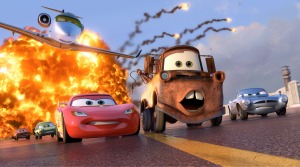
"Please tell me that wasn't Pixar back there."
1. SOPA
The “Stop Online Piracy Act” (or SOPA, for short) has been getting a lot of press lately, and for good reason. Strongly pushed by Hollywood and the RIAA, the bill is an attempt to control piracy on the internet. A worthy venture, sure, but the bill goes about it in completely inane and nonsensical ways. Essentially, SOPA would allow a third party to take down any website if they claimed it hosted infringing material. While this used to require contacting the owner of the site (and a court order and some investigation if things could not be resolved simply), SOPA would allow any third party to do it with only a judge’s signature. Under SOPA, websites can essentially be blocked and censored, without any need to even contact the website. The bill is even worse when you consider the fact that its terminology is rather vague and its sentences unnecessarily harsh. Analysts have stated that the bill could be interpreted in such ways that popular sites like YouTube could even be taken down. Indeed, many opponents of the bill have stated that SOPA would fundamentally change the way the internet works, even break it. It’s not hard to imagine — with strict penalties in place and the possibility of being taken offline ever present, websites would self-censor their content (known as a “chilling effect”) and impede the free flow of information. There’s a reason why the FCC often had a hands-off approach to the internet in the past. It’s disappointing, and even aggravating, that the media industry (and Congress with them) would go to such incredible lengths to screw over internet users, in order to make a few more dollars (dollars that, apparently, the industry is doing just fine without). Of course, I haven’t even talked about the arrogance of the US in thinking that they can police a worldwide resource. The bill has not yet been passed, as it was delayed through the holiday season, but the debate will continue well into the new year. Let’s hope Congress puts something like, oh say, the First Amendment, above the profits of an already greedy industry next year.

I couldn't find an appropriate image for SOPA, so here's a stop sign.
Posted in Uncategorized
Tags: 2011, apple, Cars 2, Cowboys and Aliens, Dinosaurs, disappointments, E3, Everyone likes Lists, Final Cut Pro X, iPad, Media Disappointments, Microsoft, Mr. Caffeine, Netflix, Nintendo, Qwikster, Sony, SOPA, star wars, tablet devices, Terra Nova, TouchPad



